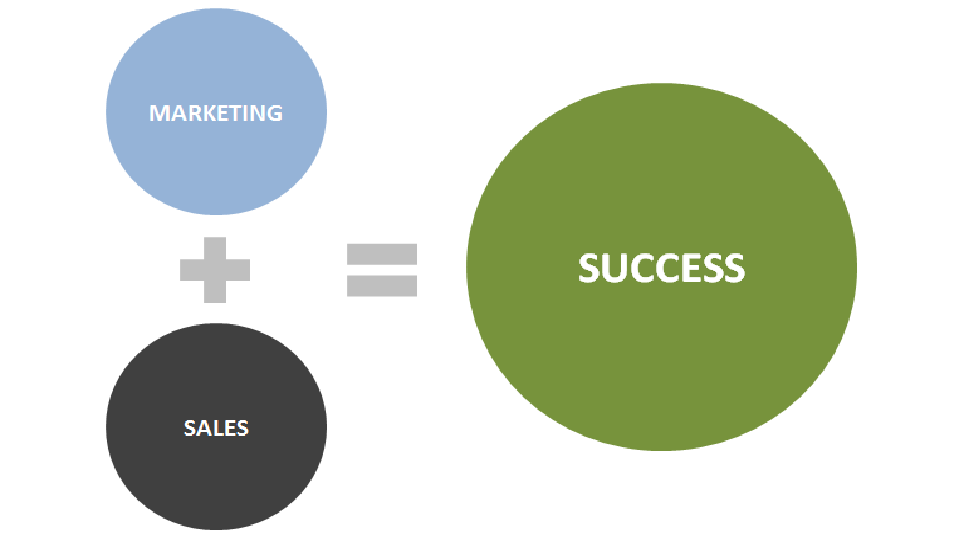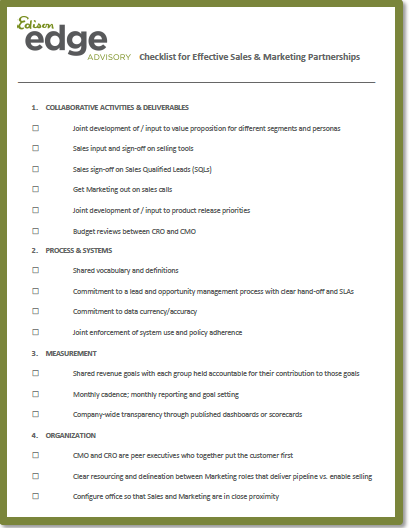We are all well aware of the natural, age-old tension between Marketing and Sales... blah blah blah. No need for me to wax on about the reasons why. In short, each group often undervalues the other’s contributions.
While it can be challenging to change behavior and break certain attitudes and habits, there are four proven strategies (supported by a checklist of steps) that can be taken to ease any pre-existing tension between Marketing and Sales. And for newly hired (partnered) Marketing and Sales leaders, the very same practices will ensure the relationship (partnership) starts off on the right footing.

Four Strategies for Strengthening Marketing and Sales Partnership
1. Put the Customer Above All Else. At Amazon, Bezos encourages his team to leave one seat open at the conference table for "the most important person in the room." That seat is occupied by the Amazon customer. A focus on customer centricity creates alignment -- who (buyer personas), how (buying process), when (buying stage), and why (buyers choose solutions like yours).
Marketing's best resource for understanding customer needs is Sales. For example, at Billtrust (an Edison company), Mitch Rose, SVP of Marketing, makes connecting with the needs of the market job #1. He does this by regularly getting out on sales calls and sitting his team alongside the Sales team. Consistently spending time with prospects and customers, and with the folks on the frontlines, helps Billtrust Marketing put customers first, and has laid the foundation for a strong partnership between Marketing and Sales at the company. And it's working - the company is growing sales 45% this year.
2. Establish Trust through Shared Goals. No one-sided agendas. Joint development of goals, budgets and execution plans says "we're in this together." Without this, there's disconnect. Devising lead, pipeline, new logo, upsell and overall revenue goals top-down and bottom-up and using a shared measurement methodology holds both teams accountable.
The best CMO candidates will have CEO and CRO references that can vouch for their experience working in this manner. For the CRO, the exercise of establishing and continually optimizing for shared goals will build his/her confidence in Marketing. This will have a ripple effect with the Sales organization when shared goals are reinforced first-hand through interactions with and deliverables from Marketing team members.
3. Embrace a Service Mentality. Leo Garneau, CMO of PHX (an Edison company growing 60% this year), subscribes to the philosophy, "If you are not satisfying your internal customer, then, as a marketer, you are missing the boat on doing the right thing for your external customer. Marketing's livelihood depends on the success of its #1 internal customer." This philosophy drives how Leo's team interacts with the Sales organization and is influenced by the fact that he started his career carrying a bag in pharma sales. As such, he understands the needs of the salesperson and knows what quality marketing support and output can do.
Embracing a service mentality requires empathy, compassion and flexibility. Marketers build trust and credibility with Sales when they flexibly respond to the needs of sales-driven situations. And it's not just about delivering leads. The Product Marketing function is one of the primary enablers of sales productivity, measured by content effectiveness and the Sales team's ability to sell the product. Their service to Sales is providing great content, and when new or different content is needed for that important prospect meeting tomorrow morning (and it's 6pm), great product marketers engage promptly with the salesperson and do whatever it takes.
4. Communicate Openly and Regularly. This is obviously core to driving alignment in support of any partnership. Per #2 above, center communication on shared goals and metrics (data driven vs. emotionally driven), using a monthly cadence with monthly reporting and goal setting. And publish a scorecard that conveys results above activity - for any/all employees, to see how Sales and Marketing is doing at any point in time.
Creating an environment that promotes candid feedback and idea sharing is key. When Marketing physically sits with the Sales team, as they do at Billtrust, this will happen organically. Organizing forums for input and feedback also fosters this -- whether that is when planning for the next release, brainstorming the next campaign, or testing new messaging and sales tools. And if Sales feels "heard," then less formal, two-way communication will develop to become a more natural and regular occurrence.
Again, per #1 above, Sales is Marketing's best resource for understanding what is truly going on in the market, so establishing this connection through open communication is a critical success factor. The quantitative stuff is the priority, but the qualitative matters, too. For example, Marketers need to know when Sales thinks a new message is not resonating in the market -- how was the message delivered, how are customers responding, what were the objections etc. Sometimes, Sales may be right, and in other cases, Sales should respect Marketing's POV when they suggest more time be given for the message to mature and stick. Without open, two-way candor, both parties lose.
And if "the fish stinks from the head," the whole company loses. The word and actions of a CMO-CRO relationship leveraging the above four strategies set the tone for a winning operation.
Need help strengthening your organization’s relationship between Marketing and Sales? Download the below checklist for some practical and actionable tips that support the above four strategies.

.png)
